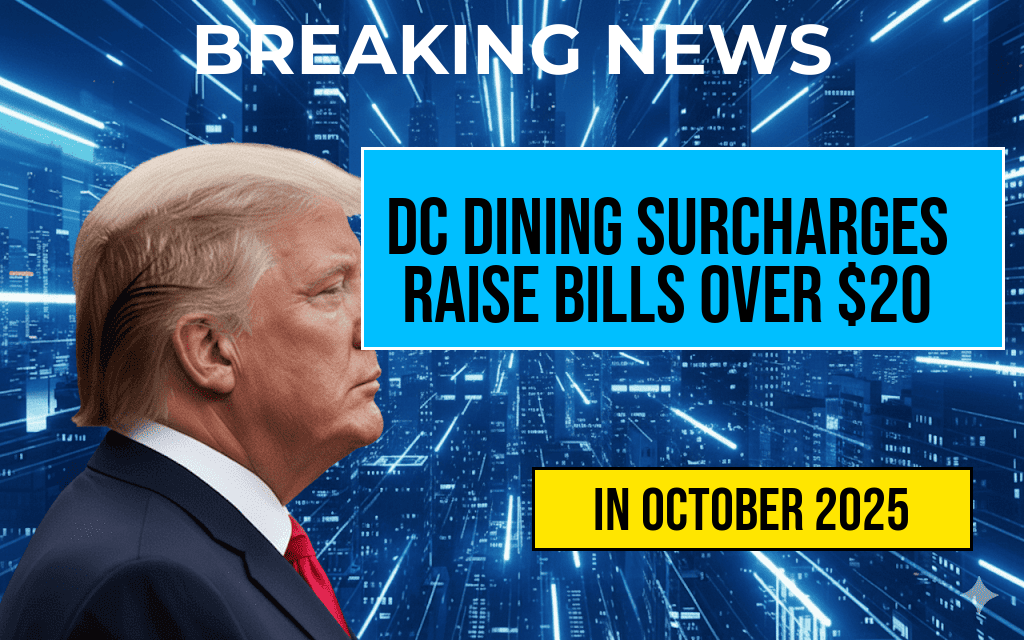DC Dining Surcharges Climb, Adding Over $20 to Average Checks as Wage Laws Shift Restaurant Economics
Recent changes in Washington, D.C.’s labor regulations have led to noticeable increases in restaurant bills across the city, with average checks swelling by more than $20. These surcharges are primarily driven by new minimum wage mandates and mandated benefits for tipped employees, prompting eateries to adjust their pricing strategies. While diners face higher costs, restaurant owners contend that these measures are necessary to ensure fair wages and improve worker retention amid ongoing staffing shortages. The shift underscores a broader national debate over balancing fair compensation with affordability for consumers, as cities across the U.S. grapple with implementing wage policies that impact the hospitality industry’s financial landscape.
Wage Regulations and Their Impact on Restaurant Pricing
Washington, D.C., has been a focal point for implementing progressive wage laws aimed at elevating standards for service workers. As of July 2023, the city increased the minimum wage for tipped employees to $17.50 per hour, a significant jump from previous levels, with further scheduled increases planned over the next few years. These policies are designed to address income disparities and improve quality of life for hospitality workers, but they come with unintended financial repercussions for restaurants and consumers alike.
Many establishments have responded by introducing surcharges—additional fees added to the bill—to offset the higher labor costs. According to industry reports, the typical surcharge ranges from 3% to 5% of the total bill, translating into roughly $3 to $5 for a $100 meal. When combined with increased menu prices, these surcharges contribute to an overall rise of $20 or more in the average dining check, especially at higher-end venues or those with larger groups.
How Surcharges Are Changing the Dining Experience
| Pre-Change Average Check | Post-Change Average Check | Difference |
|---|---|---|
| $75 | $97 | +$22 |
| $50 | $67 | +$17 |
| $100 | $125 | +$25 |
Many diners have expressed surprise at the increased costs, with some noting that surcharges are not always transparent at the outset, leading to sticker shock when the check arrives. Restaurateurs argue that these fees are a necessary adjustment to maintain profitability while honoring new wage commitments. Others have begun to reevaluate menu pricing strategies, reducing portion sizes or eliminating certain discounts to accommodate the higher labor expenses.
Industry Perspectives and Consumer Reactions
Restaurant Owners’ Viewpoint
- Cost Recovery: Many owners see surcharges as an equitable way to distribute the financial burden across customers who are enjoying the dining experience.
- Labor Quality: With wages rising, some establishments report improved staff morale and lower turnover, which can enhance service quality and customer satisfaction.
- Competitive Pressure: Smaller margins mean that some restaurants might limit menu options or reduce hours, potentially affecting local competition.
Consumer Reactions
- Surprise and Frustration: Diners often encounter unexpected fees, leading to dissatisfaction, especially when surcharges are not clearly disclosed upfront.
- Price Sensitivity: Some patrons are opting for more casual or fast-food options to avoid higher bills, affecting full-service restaurant revenue.
- Acceptance: Others acknowledge the necessity of fair wages and are willing to pay a premium as long as transparency exists.
Broader Implications for the Hospitality Sector
The increase in dining checks reflects a broader trend as cities nationwide consider or implement wage hikes for hospitality workers. The challenge lies in balancing fair compensation with consumer affordability, especially during economic uncertainties. Restaurants are exploring various strategies, including digital menu updates, dynamic pricing, and enhanced marketing to justify higher costs.
For consumers, understanding these changes is crucial. Reviewing menus for disclosures about surcharges and considering the value of improved service quality may help mitigate frustration. Meanwhile, policymakers continue to weigh the long-term benefits of higher wages against potential economic drawbacks, such as reduced patronage or increased operating costs.
As the conversation around fair wages persists, the hospitality industry in Washington, D.C., exemplifies a broader national shift. Ensuring transparency and fostering open communication between restaurants and diners could be key to navigating these economic adjustments successfully.
For more insights into wage policies and their impacts, visit Wikipedia’s page on Wage Law or industry analyses on Forbes.
Frequently Asked Questions
What are the main reasons behind the increased dining surcharges in DC?
The increased dining surcharges in DC are primarily due to recent wage regulations that require higher wages for restaurant staff. These regulations aim to improve workers’ earnings but result in higher check totals for customers.
How much have the checks increased on average due to the surcharges?
According to recent reports, checks at DC restaurants have increased by over $20 on average, as establishments pass on the costs associated with higher wages to customers through surcharges.
Are these surcharges mandatory for all restaurants in DC?
While many restaurants are implementing surcharges to offset wage increases, it is not universally mandated by law. However, the wage regulations influence most establishments, making surcharges a common practice.
Will the increased surcharges affect tipping and overall dining costs?
Yes, the increased surcharges can affect the total cost of dining, potentially leading to higher tips and overall expenses. Customers should be aware of these charges when budgeting for dining out in DC.
How are restaurants communicating these surcharges to customers?
Many restaurants are informing customers about surcharges through menus, staff, or billing statements to ensure transparency. It’s advisable for diners to review bills carefully to understand the additional charges.

Leave a Reply